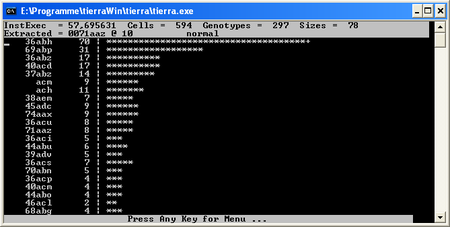Tierra (simulation)
Tierra was the first artificial life software platform to simulate experiments with Darwinian evolution using artificial organisms . The platform was presented in 1991 by Thomas S. Ray and marks the starting point of an increased research interest in the field of artificial evolution . Many properties of natural evolution could be observed in simulations with Tierra , such as the development of multicellular cells or parallel processing .
In Tierra , a population of self-replicating program units (genotypes) struggles to survive in a limited environment . At Tierra, a genotype is represented by a series of machine codes that consume computer memory and computing time. The simple genotypes or "creatures" make up the evolving population in Tierra. The evolutionary character comes into play through random errors in write operations . The different reproduction rates of the individual programs reflect different levels of fitness. In the end, the evolving population of the programs fills the entire 100 × 100 cell matrix, since programs with "fatal mutations" and thus poor fitness quickly disappear and thus die analogously to natural selection.
The programs are written in a low-level language based on assembler with two special properties in particular: Separation of operation and argument and location-independent programming . The programs written with it are therefore very robust when mutations occur .
Several projects built on Tierra and are still used successfully today to study complex evolutionary issues, such as Avida .
Individual evidence
- ^ Tom Ray, "An Approach to the Synthesis of Life," Artificial life II, 1991.
- ↑ Kurt Thearling and Tom S. Ray "Evolving multi-cellular Artificial Life," Artificial Life IV conference proceedings, pp. 283-288. 1994.
- ↑ Kurt Thearling and Thomas S. Ray "Evolving Parallel Computation", Complex Systems, 10 (3): 229-237. (June 1996)
- ↑ Publications of the Digital Evolution Laboratory (which uses Avida) ( Memento of the original from October 8, 2011 in the Internet Archive ) Info: The archive link was inserted automatically and has not yet been checked. Please check the original and archive link according to the instructions and then remove this notice.
Web links
- Tom Ray's Page on Tierra
- Artificial Life - two articles on Artificial Life and Tierra by Tom Ray at Telepolis
